Dragging the sled across the ice I approach my favourite late season trout hole. As I round the last corner of shoreline cattails, I am excited to see there is no one around. And my holes from the day before are not frozen over. This is the spring bonus: ice fishing holes that no longer freeze. I pick right up where I left off and start setting up lines in these very same holes I used yesterday. It doesn’t take long and a rod springs to life and I run over. At the hookset I swear there was no weight, but there is life, and I bring in a nice looking, but rather small trout. It is a fish though, and this makes me happy. Looking at the little guy I gently ease the hook out and release him. I am happy with the moment.
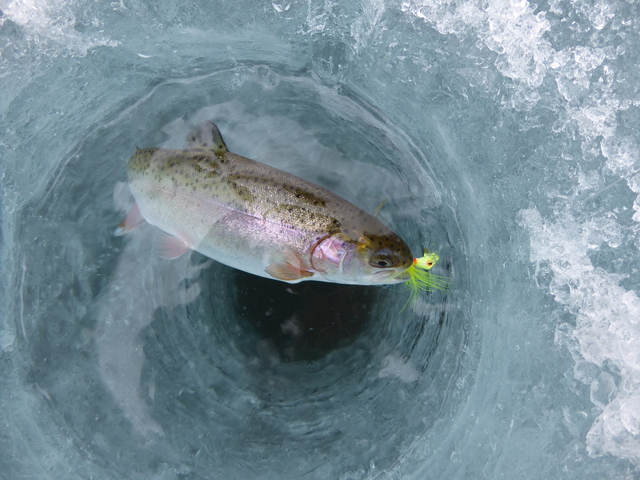
Little, but welcomed.
I rebait and send the hook half way down. I am in 10 feet of water and I am fishing about five feet down. It doesn’t take long. I hear the distinctive snap of my rod zipping skyward after being tripped in the JawJacker. At the hookset the rod stays down and it looks like this is a bigger fish. I grab the rod and engage the fish and there is weight and power. The fish pulls hard, and stubbornly the reel yields line. I hold steady. The trout gets a head of steam and easily takes 30 or 40 feet more. When I feel the resistance starting to give, it’s my turn.
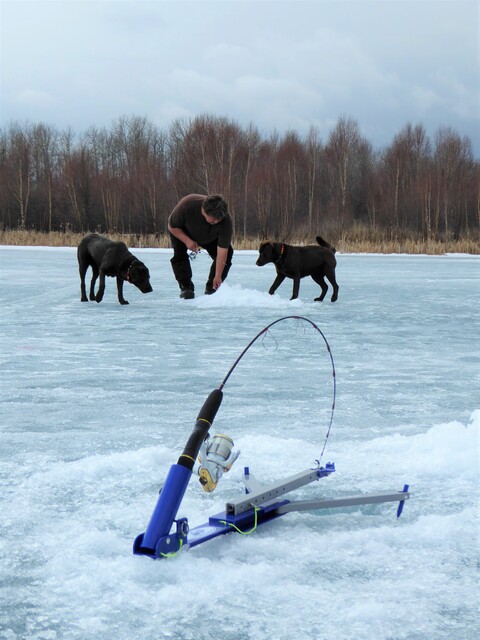
JawJackers catch fish.
I pull steady on the rod and the fish starts to come, a little at first, and then quicker. I keep up the pressure, and the trout decides this is enough and comes straight at me, blowing through the hole and out the other side. My rod folds over and the sound of my reel sings again. Without a doubt I am hooked into a good fish. Twice more I get the fish close and twice more he pulls away. This is a game of patience and I have all day. It takes a good five minutes, perhaps more, and I get the sense that the fight is swinging in my favour. The runs aren’t as athletic, or heavy. It’s easier to guide the fish. I have the fish right below the ice hole where it rolls and twists in a last ditch effort to escape. I ease off on pulling, and hold light tension until the rainbow is through with his antics. Trying to force things at the hole is where a lot of fish are lost. The trout settles and I guide him up. We get a hand on the fish and out pops a handsome rainbow, easily pushing 20 inches and 4 pounds. It’s an outstanding catch.
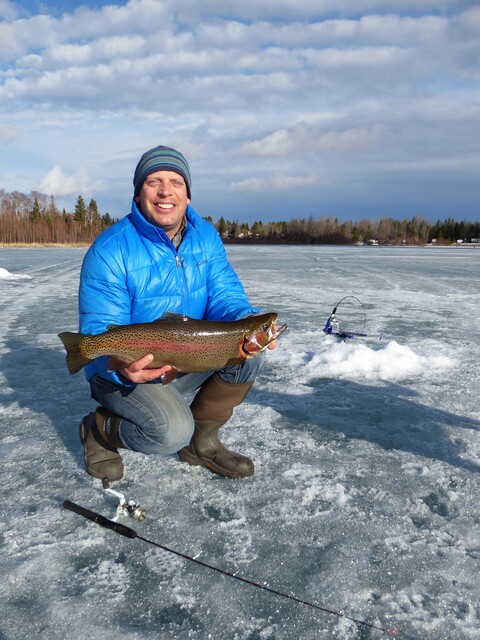
A beautiful last ice rainbow.
I am super happy with this fish, and we celebrate with cheers and high fives. The day is young, the air is warm and the fish are biting. It’s a great deal. Spring fish are opportunistic fish, and they have a propensity to bite longer into the day, and sometimes straight through from morning to night. They are not fussy about baits and I have knocked it out of the park using the standbys; maggots, trout worms, shrimp, and frozen minnows. On some lakes, especially if the water is clear, I like to jig a small bead head fly. It could be a bead head prince nymph, a pheasant tail, a scud, or a zug bug, but these small flies jigged in the spring will make many a trout become unglued. I tie the knot to the fly and twist the knot towards the point of the hook so the fly suspends horizontally. This looks more natural and gets more bites.
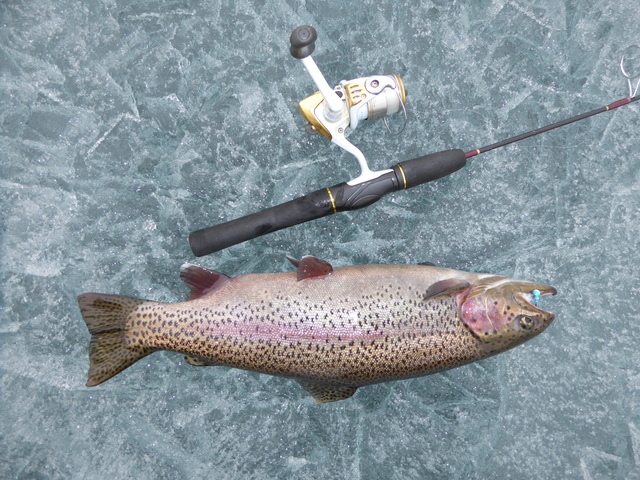
Quality rainbows are a regular occurrence.
Some days, when I have lots of time and I feel nostalgic, I tie on a wooly worm and jig it much the same way I do the bead head nymphs. Why, because it was this fly that showed me how incredibly effective ice fishing flies for trout is, and since that fateful day I’ve never looked back. It takes forever for the zero weight wooly worm to sink, but when I get it down to where the trout can see it, it gets eaten, often, and with authority. Another fly that is super effective is the bead head spratley, but watch out on the hooksets. Trout streak in on the spratley thinking it’s a minnow and the smash it into tomorrow. It’s a heavy, aggressive hit, which has caused me to break a few off at the hookset. Those other flies I spoke of though, the trout take them much more civilly.
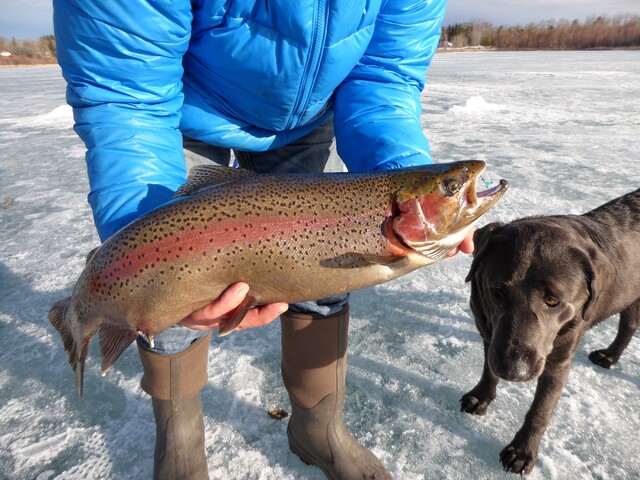
Spring trout are opportunistic.
If there is one spring presentation that never caught on, even with me, it’s jigging a floating plug through the ice for trout. It works, and it works really well, as my buddy Aaron can attest, but there are drawbacks. The fact is, trout will smash the plug, they will, but then I am dealing with 6 hook points instead of one, of which, maybe only one or two of those hook points are in the fish. The others are exposed and have a nasty habit of catching the underside of the ice as I am trying to bring the fish up, and there it is, a lost fish. But if you are into experimenting, this really works. "How might you get a floating plug to the bottom you might ask," and that is a good question. The answer is pinching on the smallest split shot that you can get away with while sinking the plug. Pinch it on just above the line knot right at the nose of the plug, so the shot and the plug are pretty much one thing. The reason for choosing a floating plug is that it is livelier, and wiggles more when jigged compared to the sinking versions and this seems to trigger more bites.
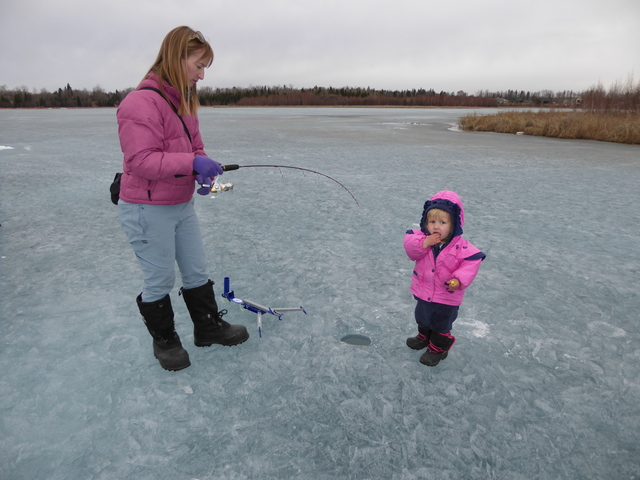
Holes don’t freeze.
The wonderful thing is that all of these presentations work and work well on last-ice, sunny day rainbows. They are hungry, active, and opportunistic, which makes for some of the best fishing of the year. When the warm days of March roll around and the ice holes no longer freeze, I bet you can guess where I am going to be.

